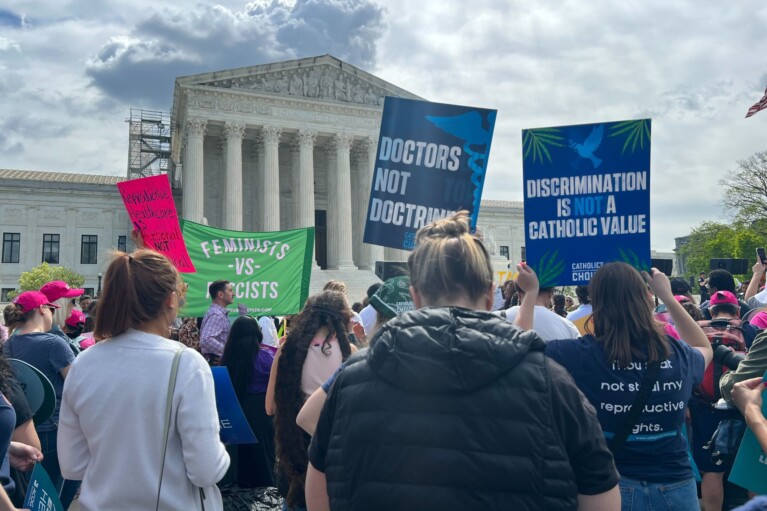Opinion: Surprise Billing Fix Shouldn’t Undermine Maryland’s Current Medical System
Congress is currently working on legislation to address surprise medical billing — an issue that impacts too many patients across the country.
As the president of MedChi – the Maryland State Medical Society – and as a patient advocate, I strongly believe that no one should be blindsided by higher than expected medical bills, especially when that patient has spent what often equates to thousands of dollars a year on health insurance premiums, deductibles, co-pays and other related medical expenses.
However, as Congress seeks to hammer out a solution to protect patients from surprise medical billing, lawmakers must be careful not to threaten access, affordability, or quality of care for some of Maryland’s — and our country’s — most vulnerable patient populations. Unfortunately, some of the approaches being considered by Congress, while well intentioned, are misguided and would do exactly that.
As well as putting our model at risk, legislation introduced in both the House and Senate would attempt to solve the problem of surprise medical billing through a one-size-fits-all benchmarking approach. Benchmarking would essentially put the government in charge of determining the rates insurers pay to physicians for out-of-network care.
While this may protect patients from getting unnecessarily caught in the middle of a billing dispute between insurers and providers, benchmarking ultimately favors insurers that have failed to fairly negotiate with physicians and, as a result, have very narrow networks.
If enacted, this government “one size fits all” rate-setting would increase the financial burden on our nation’s hospitals, emergency rooms, and other vital health care clinics serving our communities. By basically setting an arbitrary — and often low — rate that is the same across the board, benchmarking neglects the varying degree of difficulty and differing costs for providing clinical services in different parts of the country and in various kinds of facilities.
This would most likely lead to underpaying many emergency room and other doctors for the invaluable services they provide, costs which are passed onto our hospitals and health care facilities themselves. That, in turn, only serves to worsen our country’s emergency room doctor shortage and contribute to higher rates of provider consolidation — both among facilities and physicians. Ultimately, that just leads to fewer options, less control, and higher costs for patients.
Sadly, it is the patients who would ultimately suffer the most. Emergency rooms are the only health care setting required to treat all patients, regardless of their ability to pay. They are, therefore, the de facto provider of choice for some of our most at-risk and deserving patients, including children on CHIP, seniors and individuals with disabilities on Medicare or Medicaid, and uninsured and sometimes homeless patients.
When it comes to surprise billing, network adequacy and health care delivery, Maryland has always been one step ahead of the federal government. Unlike other states, Maryland currently enjoys a rate setting system, unique to Maryland known as the All-Payer Model.
This model is a contract between Maryland and the federal government, which promises that Maryland will lower costs at the same time promoting greater quality of care through an emphasis on primary and preventive care.
Because Maryland hospitals have their rates set by the Maryland Health Services Cost Review Commission, this system of care creates a safety net for uncompensated treatment as well as a stronger network of care in rural settings. Recently, the commission sent a letter to Maryland’s congressional delegation expressing concern that the proposals put forth may conflict with the goals and structure of our model.
Over the last decade, Maryland has been a leader in balancing the needs of physicians, patients and insurers. In 2009, Maryland passed legislation requiring insurers to reimburse hospital-based physicians who accept assignment of benefits (i.e., agree not to balance bill their patients) in accordance with a statutory formula. In 2016, Maryland continued its efforts by passing legislation to ensure that insurance carriers’ provider networks are adequate based upon clear quantitative standards.

Benjamin Stallings
These two measures have prompted physicians and insurers to work together to negotiate rates and be in-network providers. While more work needs to be done to address adequacy within certain health care services, such as behavioral health, Maryland has seen significantly reduced patient complaints of surprise billing as well as a doubling and sometimes tripling of network participation by physicians because of the enactment of these measures. More importantly, these successes have been achieved without disrupting existing safety nets or threatening access to care.
If Congress ultimately addresses the issue of surprise billing through federal legislation, then we request consideration of the following items. First, given the successes in Maryland to address surprise billing and the risk of disruption to our All Payer Model, we request that Maryland be granted an “opt out.” Second, for those outside of Maryland, we request that Congress consider S. 1532, STOP Surprise Medical Bills Act, which includes a provision allowing for Independent Dispute Resolution (IDR), a far more effective and fair approach to protect patients from surprise medical billing.
IDR would create an open process enabling both insurers and providers to submit their proposed payment for physicians performing out-of-network care through an online portal. This encourages each side to provide their best “offer” so that it will be accepted.
Within 30 days, an independent mediator determines a final payment, but in the meantime, hospitals and emergency rooms are paid an interim payment based on the market value of the clinical services that were provided. This is an important feature of IDR that helps keep our nation’s safety net of emergency rooms, hospitals, and other health care clinics on firm financial footing and protects them from financial stresses that could compromise access, affordability, or quality of care.
MedChi is the largest physician organization in Maryland, advocating for physicians, patients, and public health. On behalf of our members and our patients, we urge Rep. Steny Hoyer and the rest of Maryland’s congressional delegation to consider recommendations.
By doing so, they will ensure that any bill passed by Congress does not eradicate Maryland’s current protections and successes against surprise billing or endanger Maryland All Payer Model while ensuring for others a robust IDR process that protects America’s safety net health care facilities and ensures all patients have access to quality, affordable health care.
–BENJAMIN Z. STALLINGS
The writer is president of MedChi, the Maryland State Medical Society.




 Creative Commons Attribution
Creative Commons Attribution